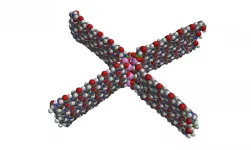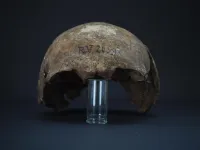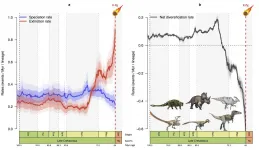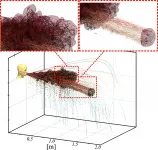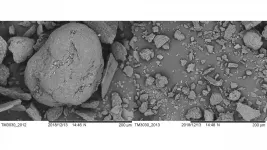Dinosaurs were in decline before the end, according to new study
2021-06-29
(Press-News.org) The death of the dinosaurs 66 million years ago was caused by the impact of a huge asteroid on the Earth. However, palaeontologists have continued to debate whether they were already in decline or not before the impact.
In a new study, published today in the journal Nature Communications, an international team of scientists, which includes the University of Bristol, show that they were already in decline for as much as ten million years before the final death blow.
Lead author, Fabien Condamine, a CNRS researcher from the Institut des Sciences de l'Evolution de Montpellier (France), said: "We looked at the six most abundant dinosaur families through the whole of the Cretaceous, spanning from 150 to 66 million years ago, and found that they were all evolving and expanding and clearly being successful.
"Then, 76 million years ago, they show a sudden downturn. Their rates of extinction rose and in some cases the rate of origin of new species dropped off."
The team used Bayesian modelling techniques to account for several kinds of uncertainties such as incomplete fossil records, uncertainties over age-dating the fossils, and uncertainties about the evolutionary models. The models were each run millions of times to consider all these possible sources of error and to find whether the analyses would converge on an agreed most probable result.
Guillaume Guinot, also of the Institut des Sciences de l'Evolution de Montpellier, who helped run the calculations, added: "In all cases, we found evidence for the decline prior to the bolide impact.
"We also looked at how these dinosaur ecosystems functioned, and it became clear that the plant-eating species tended to disappear first, and this made the latest dinosaur ecosystems unstable and liable to collapse if environmental conditions became damaging."
Phil Currie, a co-author of the study, from the University of Edmonton (Alberta, Canada), said: "We used over 1,600 carefully checked records of dinosaurs through the Cretaceous.
"I have been collecting dinosaurs in North America, Mongolia, China, and other areas for some time, and I have seen huge improvements in our knowledge of the ages of the dinosaur-bearing rock formations.
"This means that the data are getting better all the time. The decline in dinosaurs in their last ten million years makes sense, and indeed this is the best-sampled part of their fossil record as our study shows."
Professor Mike Benton from the University of Bristol's School of Earth Sciences, another co-author, added: "In the analyses, we explored different kinds of possible causes of the dinosaur decline.
"It became clear that there were two main factors, first that overall climates were becoming cooler, and this made life harder for the dinosaurs which likely relied on warm temperatures.
"Then, the loss of herbivores made the ecosystems unstable and prone to extinction cascade. We also found that the longer-lived dinosaur species were more liable to extinction, perhaps reflecting that they could not adapt to the new conditions on Earth."
Fabien Condamine added: "This was a key moment in the evolution of life. The world had been dominated by dinosaurs for over 160 million years, and as they declined other groups began their rise to dominance, including the mammals.
"The dinosaurs were mostly so huge they probably hardly knew that the furry little mammals were there in the undergrowth. But the mammals began to increase in numbers of species before the dinosaurs had gone, and then after the impact they had their chance to build new kinds of ecosystems which we see today."
INFORMATION:
[Attachments] See images for this press release:
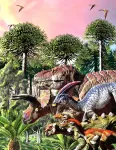
ELSE PRESS RELEASES FROM THIS DATE:
2021-06-29
WASHINGTON, June 29, 2021 -- As wind passes through a turbine, it creates a wake that decreases the downstream average wind velocity. The faster the spin of the turbine blades relative to the wind speed, the greater the impact on the downstream wake profile.
For wind farms, it is important to control upstream turbines in an efficient manner so downstream turbines are not adversely affected by upstream wake effects. In the Journal of Renewable and Sustainable Energy, by AIP Publishing, researchers from the University of Illinois at Urbana-Champaign show by designing controllers based on viewing ...
2021-06-29
WASHINGTON, June 29, 2021 -- Many meteorites, which are small pieces from asteroids, do not experience high temperatures at any point in their existence. Because of this, these meteorites provide a good record of complex chemistry present when or before our solar system was formed 4.57 billion years ago.
For this reason, researchers have examined individual amino acids in meteorites, which come in a rich variety and many of which are not in present-day organisms.
In Physics of Fluids, by AIP Publishing, researchers from Harvard University show the existence of a systematic group of amino acid polymers across several members ...
2021-06-29
The oldest strain of Yersinia pestis--the bacteria behind the plague that caused the Black Death, which may have killed as much as half of Europe's population in the 1300s--has been found in the remains of a 5,000-year-old hunter-gatherer. A genetic analysis publishing June 29 in the journal Cell Reports reveals that this ancient strain was likely less contagious and not as deadly as its medieval version.
"What's most astonishing is that we can push back the appearance of Y. pestis 2,000 years farther than previously published studies suggested," says senior author Ben Krause-Kyora, head of the aDNA Laboratory at the University of Kiel in Germany. ...
2021-06-29
Ten million years before the well-known asteroid impact that marked the end of the Mesozoic Era, dinosaurs were already in decline. That is the conclusion of the Franco-Anglo-Canadian team led by CNRS researcher Fabien Condamine from the Institute of Evolutionary Science of Montpellier (CNRS / IRD / University of Montpellier), which studied evolutionary trends during the Cretaceous for six major families of dinosaurs, including those of the tyrannosaurs, triceratops, and hadrosaurs. Using a novel statistical modelling method that limited bias associated with gaps in the fossil record, they demonstrated that, for dinosaurs 76 million years ...
2021-06-29
WASHINGTON, June 29, 2021 -- Computer simulations have been used with great success in recent months to visualize the spread of the COVID-19 virus in a variety of situations. In Physics of Fluids, by AIP Publishing, researchers explain how turbulence in the air can create surprising and counterintuitive behavior of exhaled droplets, potentially laden with virus.
Investigators from the University of Florida and Lebanese American University carried out detailed computer simulations to test a mathematical theory they developed previously. They found nearly identical exhalations could spread in different ...
2021-06-29
WASHINGTON, June 29, 2021 -- As pervasive as they are in everyday uses, like encryption and security, randomly generated digital numbers are seldom truly random.
So far, only bulky, relatively slow quantum random number generators (QRNGs) can achieve levels of randomness on par with the basic laws of quantum physics, but researchers are looking to make these devices faster and more portable.
In Applied Physics Letters, by AIP Publishing, scientists from China present the fastest real-time QRNG to date to make the devices quicker and more portable. The ...
2021-06-29
What The Study Did: This study describes four patients who presented with acute myocarditis after mRNA COVID-19 vaccination.
Authors: Raymond J. Kim, M.D., of the Duke Cardiovascular Magnetic Resonance Center in Durham, North Carolina, is the corresponding author.
To access the embargoed study: Visit our For The Media website at this link https://media.jamanetwork.com/
(doi:10.1001/jamacardio.2021.2828)
Editor's Note: The article includes conflict of interest disclosures. Please see the articles for additional information, including other authors, author contributions and affiliations, conflicts of interest and financial disclosures, and funding and support.
INFORMATION:
Media advisory: ...
2021-06-29
What The Study Did: Researchers describe myocarditis presenting after COVID-19 mRNA vaccination in 23 patients within the Military Health System.
Authors: Jay Montgomery, M.D., of Walter Reed National Military Medical Center in Bethesda, Maryland, and Margaret Ryan, M.D., M.P.H., of the Naval Medical Center San Diego, are the corresponding authors.
To access the embargoed study: Visit our For The Media website at this link https://media.jamanetwork.com/
(doi:10.1001/jamacardio.2021.2833)
Editor's Note: The article includes conflict of interest disclosures. Please see the articles for additional information, including other authors, author contributions and affiliations, conflicts of interest and financial disclosures, and funding ...
2021-06-29
This press release is in support of a presentation by Dr Ruth Howie presented online at the 37th Annual Meeting of ESHRE.
29 June 2021: Cancer treatments can cause premature ovarian failure (POI) including in girls who want to become mothers eventually. Ovarian tissue cryopreservation (OTC) provides a future fertility option but is invasive, has risks and evidence indicates that most girls don't develop POI. So, doctors face the dilemma of how to offer OTC appropriately.
Now, an assessment tool has been found to help predict correctly which female cancer patients aged under 18 years will develop POI and should therefore be offered OTC. Results from a long-term follow-up study of 423 girls and young women show nearly a quarter (24%; n = 9) of the 37 assessed as high ...
2021-06-29
WASHINGTON, June 29, 2021 - For more than 60 years, algae have been studied as a potential feedstock for biofuel production, but the cellulose in their cell wall makes it hard to access the critical molecules inside and convert them to biogas.
In the Journal of Renewable and Sustainable Energy, from AIP Publishing, an international research team reports their success in using urea and sodium hydroxide (NaOH, commonly known as lye or caustic soda) as a pretreatment of algae, which breaks down cellulose and more than doubles biogas production under their initial experimental conditions.
"We were ...
LAST 30 PRESS RELEASES:
[Press-News.org] Dinosaurs were in decline before the end, according to new study


